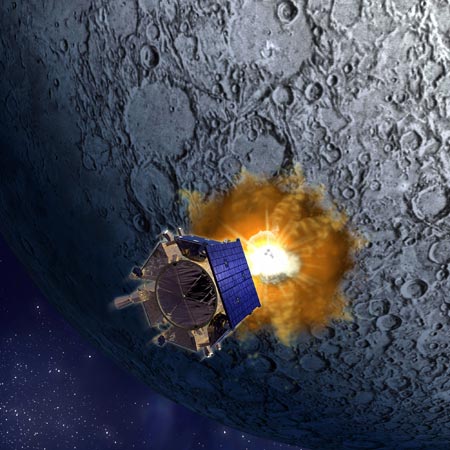America prepares to launch missiles at the moon
The US Aerospace Agency (NASA) has launched a spacecraft to bring missiles to drill a hole in the moon.

The LCROSS complex consists of an unmanned probe and a satellite that will fire missiles to the moon.Photo: NASA.
Much of the moon's surface is desert, but scientists believe ice could exist underground. The rocket carries the Lunar Reconnaissance Orbiter with LCROSS (including the Lunar Crater Observation and Sensing satellites) on June 18. The cruise's journey will last for 4 days. Upon reaching the moon's orbit, the Lunar Crater Observation ship will fire the Centaur rocket on the surface of "Sister Hang".
As soon as the rocket hits the ground, NASA scientists will analyze the dust escaping from the explosion to look for signs of water. They hope the dust will reach 6 meters high so that people can observe it from the earth. If a water molecule or ice crystal is found, NASA can expedite the construction of the base on the moon. This base will serve the mission to land on Mars in the future.
The Lunar Reconnaissance Orbiter carries seven types of scientific equipment, including cameras, infrared detectors and laser altimeters. Sensing satellite also carries a telescope covered with synthetic skin. That kind of artificial skin will help scientists assess the environmental impact of the moon on human health.
NASA has identified 50 possible bases. High-resolution cameras on the Lunar Reconnaissance Orbiter are capable of detecting objects of diameter about 50 cm or more. One of the ship's missions was to search for the remaining equipment during the lunar expeditions of 1969-1972. In addition, it will search for minerals, draw detailed temperature maps, look for areas that receive the most sunlight and map the moon's topography.
This is the first time the US has put ships on the moon since 1999. Previously, astronomers believed that thousands of meteors had brought water to the moon when they fell here. For years, at least two US spacecraft have detected signs of the existence of hydrogen and oxygen - the two elements that make up water - in the deep soil at the north and south poles of the moon.
- Japan: Missiles fall back to the launch pad in just a few seconds and then explode
- America prepares to launch the second shuttle
- Japan is about to launch a moon probe
- Video: Missiles carry satellites falling after launch
- Russian missiles fell into the sea immediately after leaving the platform
- NASA's Artemis vessel has been completed, ready to take the first woman to the Moon
- Do Americans come to the real Moon?
- How is the 'launcher and forget' weapon other than 'launch and run'?
- Russia will launch ships to the moon
- SpaceX will launch more missiles than any country this year
- NASA creates hundred-ton rockets that collect specimens from planets
- America intended to blow up the Moon
 Van Allen's belt and evidence that the Apollo 11 mission to the Moon was myth
Van Allen's belt and evidence that the Apollo 11 mission to the Moon was myth The levels of civilization in the universe (Kardashev scale)
The levels of civilization in the universe (Kardashev scale) Today Mars, the sun and the Earth are aligned
Today Mars, the sun and the Earth are aligned The Amazon owner announced a secret plan to build a space base for thousands of people
The Amazon owner announced a secret plan to build a space base for thousands of people